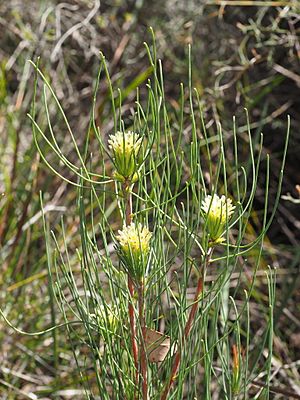Petrophile acicularis facts for kids
Quick facts for kids Petrophile acicularis |
|
|---|---|
 |
|
| Near Redmond | |
| Scientific classification | |
| Genus: |
Petrophile
|
| Species: |
acicularis
|
| Synonyms | |
|
Protea acicularis (R.Br.) Poir. nom. inval., nom. nud. |
|
Petrophile acicularis is a type of flowering plant found only in southwestern Western Australia. It's a small, bushy shrub with thin, needle-like leaves and oval-shaped flowers that are creamy white and very hairy. It belongs to the Proteaceae plant family.
What Does It Look Like?
The Petrophile acicularis is a tufted shrub that usually grows to be about 15 to 70 centimeters (6 to 28 inches) tall. Its branches and leaves are smooth, meaning they don't have any hairs.
The leaves are shaped like cylinders and are quite long, usually 50 to 180 millimeters (2 to 7 inches) in length and about 1 to 1.5 millimeters (0.04 to 0.06 inches) wide.
The flowers grow in oval-shaped clusters, about 15 millimeters (0.6 inches) long. These clusters are attached directly to the stem without a stalk. Many pointed leaves, called bracts, surround the base of the flower heads. The flowers themselves are about 10 millimeters (0.4 inches) long, creamy white, and covered in dense hairs.
This plant blooms from September to October. After flowering, it produces a type of fruit called a nut. These nuts are joined together in a round head, about 15 to 20 millimeters (0.6 to 0.8 inches) long. A special feature of this petrophile is that its cone scales have clear stripes, which helps tell it apart from similar plants.
How It Got Its Name
The plant Petrophile acicularis was officially named in 1810 by a botanist named Robert Brown. He published his description in the Transactions of the Linnean Society of London.
The second part of its name, acicularis, comes from a Latin word that means "needle-pointed." This refers to the plant's thin, needle-like leaves.
Where Does It Grow?
This type of petrophile plant usually grows in sandy soil. You can find it in the southwest part of Western Australia. Its home stretches between the Scott River, Two Peoples Bay, and Manjimup. These areas are part of the Jarrah Forest and Warren natural regions.
Is It Safe?
The Western Australian Government's Department of Parks and Wildlife has looked at the Petrophile acicularis. They have classified it as "not threatened." This means that there are enough of these plants in the wild, and they are not currently at risk of disappearing.

